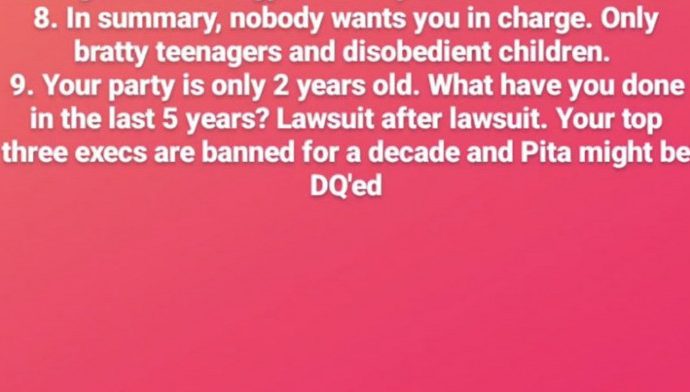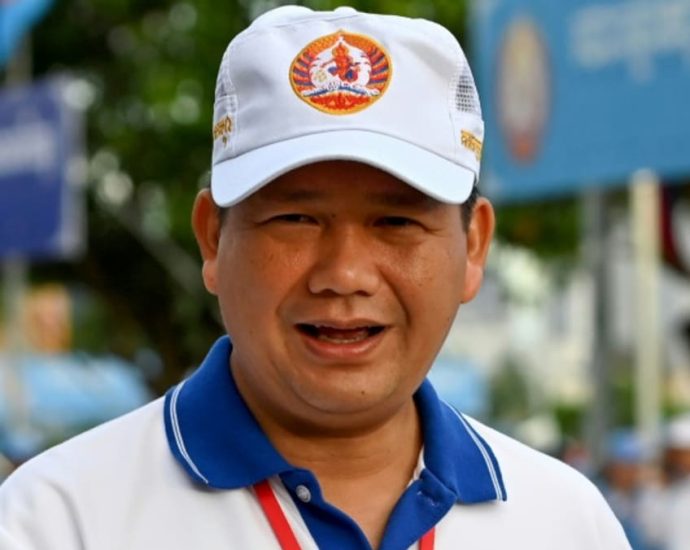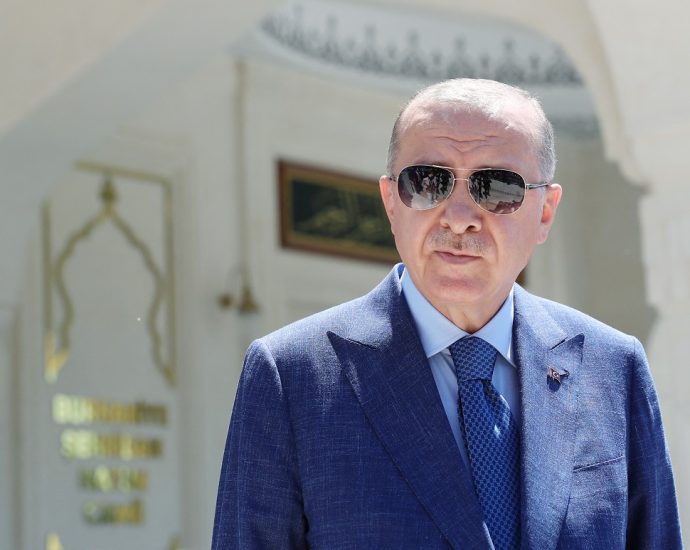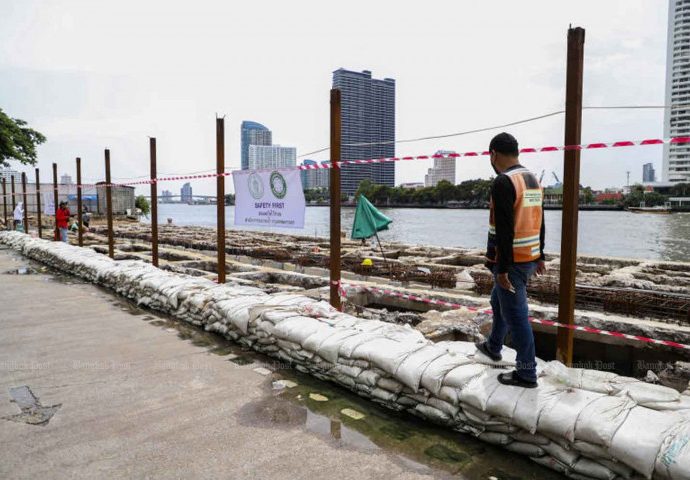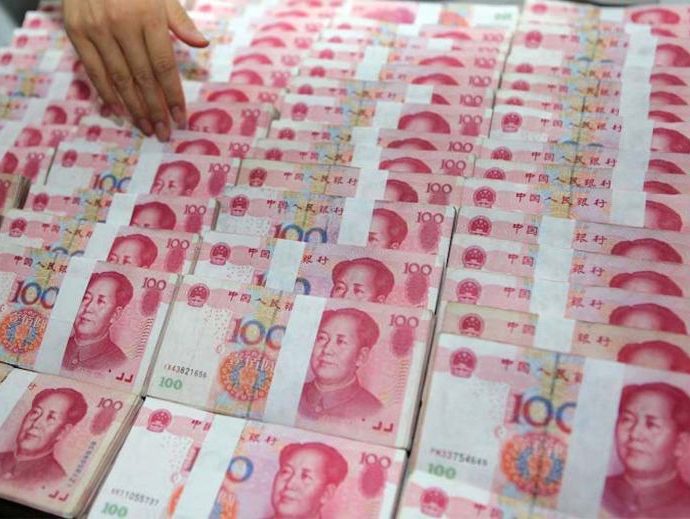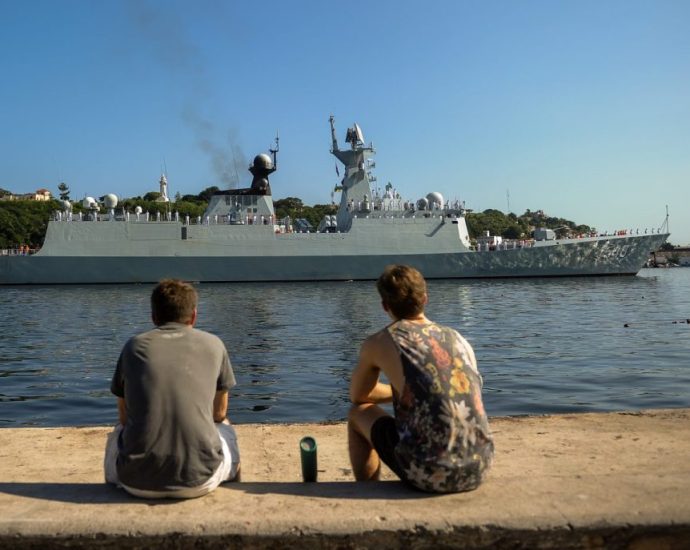Exabytes encourages businesses to leverage cloud technology for IR4.0 sustainability
Aims to address sustainability, efficiency in digital era, focusing on digital transformation
Attendees got practical solutions for optimising supply chains & embracing ESG principles
Southeast Asia’s all-in-one cloud, digital, and e-commerce solutions provider, Exabytes Group, recently organised the Cloud-Powered Industry 4.0 Revolution conference with Amazon Web Service (AWS). The conference aimed to create awareness for businesses to…Continue Reading
Bangkok governorâs son apologises for anti-MFP rant
Sanpiti Sittipunt roasted online for branding ‘woke’ party supporters as ‘bratty teenagers’

The son of Bangkok Governor Chadchart Sittipunt has apologised for an online tirade against the Move Forward Party, in which he called its supporters “bratty teenagers”, among other things.
Sanpiti “Sandee” Sittipunt, 23, was himself the target of widespread online abuse on Monday after he posted the Instagram message, which has since been deleted.
He branded the supporters of the coalition-leading party as “bratty teenagers and disobedient children” and criticised the party for lacking feasible economic policies and more.
Mr Sandee, who worked as a Pheu Thai campaign volunteer, wrote his commentary in English. “You had your turn,” he began, referring to Move Forward leader Pita Limjaroenrat’s unsuccessful first bid to be approved as prime minister by parliament. “Let us, Pheu Thai, lead Thailand to the future We delivered on economic priorities for the past 20 years.
“Thailand has the potential to become the 5th Tiger. We cannot achieve it if you keep complaining about social issues and laws. We must focus on the economy and how to bring money to people’s pockets. Move Forward is the party of wokeism and cancel culture.”
Amending section 272 of the constitution to curb the power of the Senate, as Move Forward proposes, will “never happen”, nor will amendments to other controversial laws.
“Pita as PM will never happen. NEVER,” he added.
“Next election, maybe try getting 65% of the vote like 2005 with Thai Rak Thai and I’ll reconsider my stance.
“You don’t have any feasible economic policies. Monopolies and big corporations don’t want you in power. Farmers want policies that cash them cheques, not gender ideology or woke performative bullshit.
“In summary, nobody wants you in charge. Only bratty teenagers and disobedient children.”
The internet predictably exploded, with Move Forward supporters directing pointed and sometimes personal remarks at the overseas-educated son of a prominent political figure. Within hours, Mr Sanpiti was in retreat, publishing an apology on his Facebook page.
“I regret my actions and would like to explain that I was only trying to express my opinions, I do not harbour hatred towards any parties or individuals,” he wrote. “Moving forward I am willing to listen to other people opinion as well as learning from everyone.
“To be clear, I think MFP policies are very practical and transformational, very innovative. I just don’t like the leadership or the people involved as well as the entire protest movement in 2020 .
“I fully own up that I am very privileged and elitist, that I am inexperienced and uneducated about Thai politics or politics. It is inappropriate and ill-advised of me to comment on politics despite my right to free speech. I am not qualified.
“Over the past day, I have read hurtful comments about my physical stature, my intelligence and my background. While everyone is entitled to their own opinion, I admit that this is the consequence of my actions and I have enabled this. We must show empathy and kindness to others.”
Mr Chadchart said on Tuesday that his son regretted having written the diatribe. He said he spoke with his son about the matter and encouraged him to be “constructive” when expressing opinions.
The governor told TV Channel 3 that he did not force his son to issue an apology.
Mr Chadchart was a popular transport minister in the Pheu Thai government of Yingluck Shinawatra. He later left the party in 2019 and ran as an independent for Bangkok governor in 2022, winning one of the biggest victories in the capital’s history.

An excerpt from the post, since deleted, that Sanpiti Sittipunt made on Instagram.
Succession plan: Cambodia PM’s favoured son on path to power
By contrast, his son was raised in luxury and educated abroad, including at the US military academy West Point. But a Western education is no guarantee of a more liberal approach, exiled politician Sam Rainsy, a longstanding foe of the prime minister, told AFP – pointing to Syria’s brutal AssadContinue Reading
Calling Erdoganâs bluff on NATO

Last week, on the eve of NATO’s summit in Vilnius, Turkish President Recep Tayyip Erdogan finally ended his opposition to Sweden’s membership. After months of brinkmanship and threats, he realized that his poker hand was relatively weak. Except for Hungary, other NATO states had become exasperated with his theatrics.
Erdogan parlayed his resistance – first to the membership bids of both Finland and Sweden, and later just to Sweden’s – to re-election this spring. Erdogan controls domestic sources of information in Turkey; appearing to strongarm the West is a popular political ploy.
But Erdogan is also interested in playing a larger role in global politics. He has an inflated view of himself and of Turkey; imagines that he can singlehandedly remake the global balance of power; and believes that forcing others to negotiate with him will enhance his credentials.
In rationalizing his opposition, Erdogan accused the Swedes of harboring “terrorists” who sought asylum from his authoritarian regime. The problem is that for Erdogan, every opponent of his government is a terrorist. He has eviscerated the notion of the rule of law in Turkey – from finance and human rights to freedom of the press and day-to-day societal choices.
Without an independent judicial system, it’s impossible to determine whether Turkey’s extradition requests have legal merit. At one point, the Turks even demanded that a sitting member of the Swedish parliament, who happens to be of Iranian-Kurdish origin, be handed over.
Most of Erdogan’s requests were those no democratic country could agree to. Rather than heed his demands, the Swedes agreed only to extradite a drug dealer and tighten rules regarding fundraising for Kurdish groups directly affiliated with counterparts in Turkey.
Erdogan doesn’t understand that Turkey’s position is hypocritical when it comes to requesting the extradition of criminals.
Sweden had made several requests to Ankara to arrest and start extradition procedures for fugitives, drug dealers, and suspected murderers who have sought refuge in Turkey. Turkey refused these entreaties on account that the suspects now were Turkish citizens – having achieved this feat by literally buying their residency status.
Turkey wasn’t always the troublemaker of the North Atlantic Treaty Organization. Erdogan was influential in the early years of his presidency when he sought to establish a moderate, liberal order at home and improve relations with allies and neighbors alike.
But as he consolidated power he became a populist-authoritarian leader with no tolerance for dissent. Surrounded by sycophants, he has gotten accustomed to getting his way at home, no matter the issue.
His real problem, and the reason he had to end his opposition to Sweden’s NATO membership, is that he’s facing an enormous economic crisis, much of it his own doing. He espouses unorthodox policies that have sent inflation through the roof.
To avoid calamity, Turkey will need vast amounts of financial help, aid with its current-account deficit, direct foreign investment, and improved market access for its manufacturing-sector exports. This is the kind of support only Turkey’s allies can provide.
EU membership gambit
Before consenting to Sweden’s NATO membership, Erdogan tried to turn the tables: He set as a precondition that the European Union agree to reopen accession negotiations of its own with Turkey.
This is a non-starter, and he knows it. But posing the question could prompt the EU to consider deepening its customs agreement with Ankara, a move that would undoubtedly help Turkish exports.
Jens Stoltenberg, the NATO secretary general, did express support for Turkey’s EU accession. Of course, the endorsement is in essence meaningless, given that Stoltenberg isn’t an EU official. Yet Erdogan will still seek to spin this as a concession to Turkish demands.
Erdogan also wants US President Joe Biden’s administration to approve the sale of F-16 fighter jets to Ankara.
The administration, which supports the idea in principle, made it clear that as long as Erdogan blocked Sweden’s NATO bid, the sale wouldn’t fly in the US Congress, where some leaders were already upset at Turkey’s threatening overflights of Greek islands in the Aegean and other abrasive tactics in the region.
The Turkish Air Force needs F-16s because it lost its chance of acquiring more advanced F-35s on account of another case of obstinate Erdogan decision-making: the purchase of Russian S-400 anti-aircraft missile systems.
The president authorized this move despite warnings from Washington and NATO that the systems rendered the F-35 susceptible to Russian espionage and are incompatible with alliance equipment.
The Biden administration managed this crisis exceptionally well; it was patient and kept its powder dry. It probably bemoans the many hours it wasted dealing with this issue when other, more pressing ones got short shrift.
Unfortunately, this is the world of dealing with populist authoritarians; Erdogan isn’t the only one, and he will be back. He indicated that he would submit the Swedish accession legislation to the Turkish parliament in October after the end of the summer recess.
In other words, the Turkish president has plenty of time to try to up the ante, make other demands, or complain that the rest of Turkey’s allies aren’t living up to the deal’s conditions.
The debate over Sweden’s accession to NATO may be over, but Erdogan’s self-serving brinkmanship will only continue.
This article was provided by Syndication Bureau, which holds copyright.
Opposition meeting: 26 Indian parties hold talks to take on PM Modi
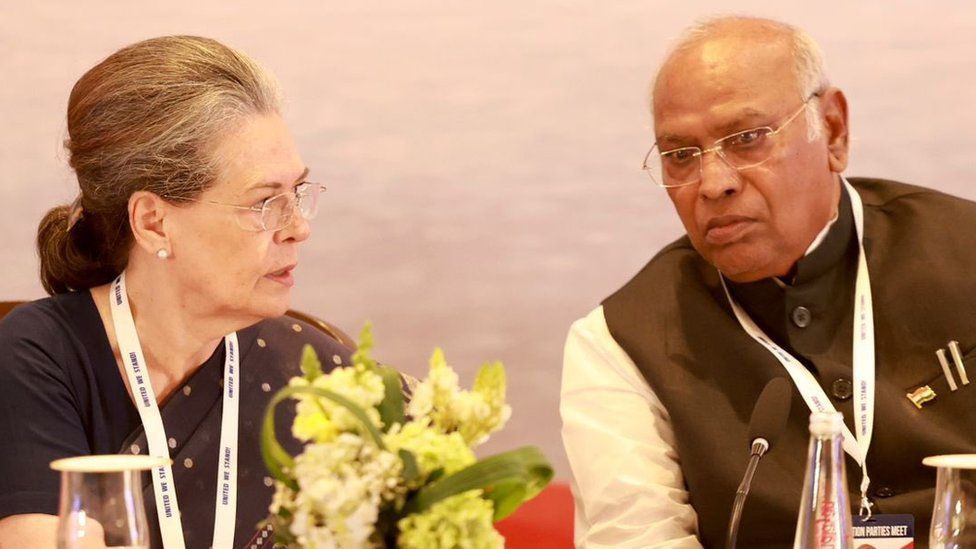 Congress Party
Congress PartyThe leaders of 26 Indian opposition parties are meeting to firm up their strategy to take on Prime Minister Narendra Modi’s party in the general election due next year.
Top opposition leaders including the Congress’s Sonia Gandhi and Delhi chief minister Arvind Kejriwal are participating.
Reports say the group may also pick a leader for the coalition on Tuesday.
This is the second big meeting of the opposition in the run-up to elections.
They are expected to discuss issues such as seat-sharing – how many seats each party would contest – and a common programme for the election in the two-day meeting being held in Bengaluru city (formerly Bangalore) in the southern state of Karnataka.
But taking on the BJP – which won more than 300 seats in the 543-member Lok Sabha (the lower house of India’s parliament) in 2019 – will be a formidable challenge even for a mostly united opposition.
The BJP governs around 15 states (India has 28 states and eight federally administrated territories) either by itself or as part of a coalition. It is India’s richest political party with a declared income of 19.17bn rupees ($233.67m; £178.4m) in 2021-22. And its biggest strength in a national election is the popularity of Mr Modi, who has been able to sway even voters who may have chosen a different party in state polls.
Meanwhile, opposition parties are grappling with their own challenges.
Rahul Gandhi, leader of the Congress party, was disqualified as an MP in March after he was convicted and sentenced to jail in a defamation case related to comments made about Mr Modi’s surname at an election rally in 2019. Unless his legal appeal is successful, he cannot contest next year’s election.
Many of the opposition parties are also at loggerheads with each other in states such as West Bengal and Delhi due to differing political ideologies.
Some, like the Nationalist Congress Party, are battling internal defections, while others are trying to deal with a lack of unity among senior state leaders.
However, observers say that a strong anti-BJP sentiment is uniting the opposition, pushing them to look past their differences.
On Monday, Congress president Mallikarjun Kharge said that opposition parties will “work closely together to foster an agenda of social justice, inclusive development and national welfare”.
“We want to free the people of India from the autocratic and anti-people politics of hate, division, economic inequality and loot,” he added.
Reports say that Sonia Gandhi may be chosen as the coalition’s president, but there is no official confirmation yet.
Meanwhile, the BJP-led National Democratic Alliance is also set to hold a meeting of 38 allies on Tuesday in the capital Delhi.
On Monday, BJP president JP Nadda had criticised the opposition meeting, saying its foundation was based on “the politics of selfishness”.
BBC News India is now on YouTube. Click here to subscribe and watch our documentaries, explainers and features.

Read more India stories from the BBC:

-
-
30 January

-
BMA prepared for flooding as storm nears
PUBLISHED : 18 Jul 2023 at 12:56

The Bangkok Metropolitan Administration (BMA) is fully prepared to cope with the heavy rain and flooding expected to be brought by tropical storm Talim, a senior official said.
Surat Charoenchaisakul, director of city drainage and sewerage, said on Tuesday the flood prevention control centre had been instructed to closely monitor the storm’s movement and forecasts issued by the Meteorological Department.
The BMA weather radar station was monitoring the movement of rain clouds heading for Bangkok and its vicinity, so that precautions could be implemented. Water levels in canals and retention areas had been lowered under the flood prevention plan.
Mobile rapid response units were ready for deployment to flooded areas, including tunnels, to make sure that floodwater is drained off quickly, he said.
All pumping stations were being staffed around the clock to ensure all equipment and back-up power generators were functional. Mobile water pumps, cranes, balloon lights, fuel and other equipment were on standby, ready to be sent where needed.
All construction sites had been asked to ensure effective drainage.
Several meetings had been held with local administrations in adjacent provinces to lay down plans for flood relief operations, Mr Surat said.
Chinaâs financial regulatory regime finding its feet
On March 16, 2023, Beijing released an official plan to reform Party and state institutions. This document lays out plans to address deficiencies in the ability of the Chinese government’s own institutions to lead the nation’s development. Part of the 2023 plan is to reform and restructure the financial regulatory framework.
According to the plan, a central commission for finance will be established as the Central Committee’s own decision-making institution — designing, coordinating and overseeing the country’s efforts to achieve financial stability and development.
It will replace the existing State Council’s Financial Stability and Development Committee. This is Beijing’s way of enhancing its authority over a financial sector that has become a source of turbulence in recent years.
A new national regulatory body, the National Bureau of Financial Regulation, will also be set up. It will oversee consumer rights protection and regulation of the financial industry except for the securities industry. The China Banking and Insurance Regulatory Commission will be abolished and the PBOC will focus on monetary policy and macroprudential regulation.
China’s financial regulatory framework has come a long way from a one-regulator structure to the current one bureau, one commission and one bank structure. Before 1990, China’s financial sector consisted of a few state-owned commercial banks and the PBOC was the only financial regulator.
China’s financial industry started to change in the early 2000s as cross-sectorial financial products, such as bank wealth management products, began to emerge. This has posed challenges to the sectoral regulatory framework as these blended financial operations require supervision from more than one regulator.
It also creates room for circumvention of regulation in territories where supervisory responsibilities are unclear and rent-seeking in areas where supervisory responsibilities are overlapping.
In an attempt to address supervisory inefficiency, the State Council approved an inter-ministerial joint meeting system for all financial regulators to coordinate cross-sectorial regulations in 2003. This failed to achieve its goal because none of the regulatory bodies had actual executive power to lead the way.
Beijing started a major reform in 2017–18 after seeing turbulence in the stock market, real estate market and internet financing in the past few years. First, the Financial Stability and Development Commission was created under the State Council in 2017.
This commission is on a higher administrative ranking than the existing regulators, which ensures that it has the executive power to mobilize others to tackle major issues and to lead financial reform. Then the Banking Regulatory Commission and the Insurance Regulatory Commission was replaced by a China Banking and Insurance Regulatory Commission in 2018.

The 2017–18 reform shows a gradual transition from sectorial regulation to functional regulation as Beijing responds to the changing financial sector. The 2023 reform is a continuation of this transition, and yet shows Beijing’s pressing concern about financial risks and desire for a stronger grip over the financial system.
The Central Commission for Finance was created in 1998, after the outbreak of the Asian financial crisis, to centralize forces to stabilize the economy and coordinate risk management. Its resurrection today suggests that Beijing’s concern over the financial system has reached the same level as during the crisis.
The 2023 plan also seeks to optimize the central bank’s structure. All the regional branches, which operate across multiple provinces, will be removed.
Instead, there will be one provincial-level branch in each of the 31 provinces and five separate branches in the cities of Shenzhen, Dalian, Ningbo, Qingdao and Xiamen. It will be a better central–local structure for monetary policy implementation and macroprudential regulation.
Local financial regulatory frameworks will be modified. Central financial regulators will send out local agencies to oversee, coordinate and implement financial supervision and reform, in collaboration with local governments’ own financial regulatory bodies.
Local governments are no longer responsible for promoting financial development. Rather, they have been given the clear task of reining in financial risks. It is clear that Beijing wishes to control financial supervision at the local level as much as at the national level.
The reform of the local financial regulatory framework arises from a deep concern over the scale of local government debt. In 2022, the Chinese local government’s debt reached 35 trillion RMB (US$4.8 trillion) and the local government financial vehicle (LGFV) debt was close to 60 trillion RMB ($8.3 trillion).
Beijing has recognized the risks embedded in this multi-trillion local government debt and aims to resolve implicit LGFV debt via large-scale debt restructuring and swapping. Reform of the local financial regulatory framework will ensure that Beijing will lead the debt restructuring at the local level while making the local governments accountable for controlling financial risks.
The 2023 round of financial reform comes at an extraordinary time for the Chinese economy. The external environment is uncertain again, due to the pressure of high inflation and tightening monetary policy in advanced economies. Domestically, slow growth, accumulating systemic risk and the shrinking policy room are the biggest challenges.
Given the uncertain economic outlook, it is increasingly critical that the plan for reforming the financial regulatory framework will be implemented seriously. The National Bureau of Financial Regulation is key to this plan. On May 10, 2023, it was officially open for business — we will wait and see whether it can get the job done.
Jiao Wang is Research Fellow at the Melbourne Institute: Applied Economic & Social Research, University of Melbourne.
This article was originally published by East Asia Forum and is republished under a Creative Commons license.
Facebook in Cambodian politics

Many Cambodian people started to familiarize themselves with Facebook probably in the late 2000s. Back then, people used it simply to connect with friends.
Cambodia started to see Facebook being used in the political domain mainly from the 2013 general election.
It is not far-fetched to say that Facebook was a major communication tool in pushing the opposition in Cambodia to win an unprecedented 55 seats in 2013. The opposition also used Facebook to mobilize people to the unprecedented mass protest in December 2013. The protest took a violent turn in January 2014 with destructive demonstrators who were later cracked down on by the government.
For the opposition, the chain of events had brought them an inch close to toppling the Hun Sen regime and gaining power. For the ruling Cambodian People’s Party (CPP), the events were putting the country an inch close to civil war.
The CPP was finally awakened to the danger of a color revolution, which was not yet a known concept in Cambodia at that time.
Similar political events can be seen around the world during that period, for instance the Arab Spring that occurred between 2011 and 2012 in countries such as Tunisia (Jasmine Revolution), Egypt, Libya, Syria and Yemen. Documentaries were made to suggest a major role of Facebook in launching these color revolutions.
The results of the Arab Spring were nothing but tragedy and endless crisis. What started off as peaceful pro-democracy protests turned into civil wars in Libya, Syria and Yemen, displacing or killing millions of people. Tunisia lost stability. Tunisia has had 12 governments in the last 10 years. Some questioned why after 10 years since the Arab Spring, countries that fought for dignity and democracy are still far from it.
The violence in 2013-2014 gave CPP a big lesson in terms of communication strategy.
The CPP believed that it had left Facebook to be monopolized by the opposition and had ignored this space for far too long. The CPP was a latecomer in terms of utilization of Facebook in politics. It was not until September 20, 2015, that Prime Minister Hun Sen officially launched his Facebook page.
The battle on Facebook increased in the run-up up to 2018 election, with more CPP supporters becoming more active to increase their political space on Facebook. The opposition thus lost its monopoly on Facebook.
In general, those who can read Khmer can understand that the political battles on Facebook are fierce.
As the mainstream media tend to perceive that the Cambodian government is authoritarian, there has been less scrutiny of the ways the opposition have been communicating their political messages, which were violent and racist. Their messages are often written in Khmer to hide them from the eyes of English-language media.
The opposition has taken this kind of political culture since the first election in 1993 by undermining the trust toward the government in whatever means possible, including promoting division of classes, encouraging civil disobedience and military mutiny, and inciting anti-Vietnamese and later anti-Chinese sentiment among voters.
It took 24 years for the Special Rapporteur on the situation of human rights in Cambodia to acknowledge on September 27, 2017, that the opposition were using hate speech. In a very indirect and soft tone, the then-Special Rapporteur Rhona Smith wrote in her statement that “the same is true of earlier rhetoric from other parties inciting hatred.”
Direct stakeholder
In 2023, as Cambodia is approaching another election, Facebook has undergone a major turning point in Cambodian politics by changing its role from being a mere political platform to adopting a role akin to a regulator.
This is nothing but becoming a direct stakeholder of Cambodian politics.
In late June, Facebook’s oversight board recommended that the platform suspend the Cambodian prime minister’s account for violent language. In response, Hun Sen deleted his Facebook account with more than 14 million followers, and the government expelled Facebook representatives and stopped all activities it had with Facebook.
It said in a statement that the government had found irregularities in Facebook’s services for users in Cambodia, such as the creation of fake accounts, risk of private data, use and collection of private data, dissemination of fake news, lack of accountability and transparency, and interference in the country’s political affairs.
The members of the oversight board were later declared persona non grata.
When a dozen of unelected private individuals, completely unknown to the Cambodian public, attempt to censor the prime minister’s speech within Cambodian political discourse, this is direct interference by a private foreign company in the domestic affairs of a sovereign state.
So a red line has been crossed by Facebook, and Cambodian leaders have lost their trust in the platform.
From Facebook’s perspective, probably there is nothing it can do about its inability to control the vast pool of messages with ill intentions, especially when the platform allows fake identities to exist.
When “likes” and “shares” are the motivational drives for Facebook users, it can create a breeding ground for extremism and populism.
From the government’s perspective, it is extremely problematic when the authorities cannot enforce the law against those who insult His Majesty the King, make slanderous comments against the dignity of public individuals, or disseminate fake border maps to accuse the government of ceding territory to a neighboring country.
In fact, Cambodia’s is not the only case in which states have difficulty striking a balance between the promotion of the freedom of expression through the flourishing social media and the maintenance of the rule of law and public order.
In France, Facebook was considered a supportive tool for violence by the gilet jaunes in 2018. Facebook’s latest algorithm change favors wildly popular organic posts, rather than those from media organizations and the gilet jaunes’ protests have benefited from the new code. In the recent violent protests, President Emmanuel Macron also blamed social media for fueling violence.
Nonetheless, maybe it is hard to blame Facebook and other social media because basically they are not accountable for state’s security and public order.
When Facebook cannot assist the government in enforcing the rule of law, governments have no choice but to find their own ways and means, because the government is the elected representative of the people, and it has to be accountable toward the people in terms of protecting peace, rule of law, security and public order.
After all, what is the purpose of authority if the rule of law cannot be enforced? This question touches to the core raison d’etre of the state itself.
As the trend continues, it is not hard to see that the Cambodian government has started to reconsider its view about Facebook in terms of political communication tool, and to seek better ways to handle social media while trying to maintain the rule of law, national security and public order.
Robots that deliver medication, voice-activated devices: Hospitals tap technology to improve patient care

Another robot guides people to different areas of the emergency department, relieving nurses of the task of escorting patients in person, which typically takes one-and-a-half hours a day in total.
The consultation room is “quite a distance” away from the triaging area, said Ms Cheong. It speaks four languages – English, Mandarin, Malay and Tamil.
A third robot can perform dedicated tasks, such as providing patients in the waiting area with items they need like a blanket. The robot alone has reduced the workload of retrieving items by nearly half.
This means service staff can focus on other tasks like helping patients with payment or discharge queries.
The robotic trial is expected to end in August. CGH is looking to deploy the robots for more tasks or mobilise the machines elsewhere in the hospital.
SMART WARD AT TTSH
At Tan Tock Seng Hospital’s (TTSH) Smart Ward, several devices have been introduced to make healthcare more efficient.
One device allows nurses and doctors to update one another quickly hands-free, without the use of the phone.
With the completely voice-activated device, nurses can say the name of the doctor they are looking for, and the device will connect them.
“Traditionally, we have to pick up a phone, find the contact number of the doctors and then dial and connect with the doctors and wait for the doctors to arrive on site to the ward,” said Smart Ward lead and senior nurse manager Lim Mei Ling.
They can also use the device’s camera to scan items like medication or bandages for doctors to assess the situation and make a call on what to do next for a patient, saving time, Ms Lim added.
The device is one of 20 innovations that have been tested at the TTSH Smart Ward since 2022. Another new technology at the ward is a bed that turns bed-bound patients with the push of a button, reducing the need for labour-intensive work.
China cranking up production of game-changing frigate
China’s massive naval shipbuilding program is gaining steam with the rapid construction of next-generation combatants, a building spree that promises to free up older warships for coast guard patrols in disputed maritime areas in the East and South China Seas.
This month, Naval News reported that production of China’s new Type 054B frigates is now underway at Hudong in Shanghai and Huangpu Wenchong in Guangzhou, the same shipyards responsible for producing the Type 054A frigate, of which the People’s Liberation Army-Navy (PLA-N) operates 40 units.
Naval News mentions that the Hudong and Huangpu shipyards also produce a modified Type 054A adapted for the China Coast Guard (CCG), designated Type 818, and continue work on a newer redesigned variant.
Naval News reports that the Type 054B is a new warship that is wider and longer than its Type 054A predecessor, with an estimated length of 147 meters, a beam of 18 meters, a bulkier superstructure and a higher bridge with a 6,000-ton displacement.
The report notes that while the Type 054B’s armaments and other subsystems are still unknown, they will most likely include a 32-cell vertical launch system (VLS), a new type of active electronically scanned array radar (AESA), and a possible H/PJ-11 11-barrel 30 mm autocannon on the bridge like the Type 052D destroyer and Type 055 cruiser.
It is also expected to house two Z-20 utility and anti-submarine helicopters, replacing the lighter and less-capable Z-9 used on the Type 054A.
Naval News mentions that the Type 054B frigate under construction at Huangpu has already been painted, and launch appears likely in the next couple of months. The hull at Hudong was floated out in early June to make way for a civilian vessel but was then returned for further work.
The Naval News report notes that both hulls may be launched before yearend, with the sighting of more modules at Hudong suggesting that China is building more frigates.
Asia Times noted in February 2023 that the Type 054B was first designed in 2016 and is the final form of the Type 054A design. It is intended to be a low-end, anti-submarine ship working alongside the high-end Type 055 cruisers and Type 052 destroyers, which are too expensive to build in greater numbers.

The Type 054B is expected to operate within the First and Second Island Chains. It may also be tasked to secure China’s sea lines of communication (SLOC) connecting major seaports across its Maritime Silk Road, with its larger size enabling it to carry more fuel and onboard stores to increase its endurance and self-sustainability on the high seas.
It may also operate alongside China’s carrier battlegroups, with its improved propulsion systems solving the Type 054A’s significant handicap of being too slow to keep up with the Type 052 destroyers and Type 055 cruisers in an escort role.
South China Morning Post (SCMP) noted this month that the Type 054B is actually a “mini Type 055”, meaning it may feature technologies aboard the latter ship such as high-power microwaves or shipborne drones.
SCMP also says China plans to have four carrier strike groups by 2030, with the Type 054B, Type 052D and Type 055 serving as the critical escort vessels for its aircraft carriers.
Accelerating the Type 054B’s construction may also enable China to beef up its coast guard vis-à-vis its East and Southeast Asian neighbors in areas of dispute. China has a track record of converting older warships into maritime law enforcement vessels.
Combining a warship’s design endurance and resilience with the legal status of a civilian ship allows China to flexibly implement its “gray zone” tactics, including sometimes risky maneuvers that pull up short of lethal force to confound its adversaries’ response options.
The US Department of Defense (DOD) 2022 China Military Power Report mentions that, in 2021, China transferred as many as 22 early units of its Type 056 corvettes from the PLA-N to the CCG due to its lack of towed array sonar, limited range and small storage capacity. Also, as more blue water capable ships enter PLA-N service, the need for coastal defense warships such as the Type 056 has decreased.
SCMP noted in February 2022 that a Type 056 corvette with hull number 511 had been modified by the Hudong shipyard for CCG service, removing the ship’s torpedo tubes and missile launchers but keeping the 30mm autocannons and 76mm main gun in place.
SCMP also says LED panels were added to the ship’s sides, allowing it to display warnings and messages. The source also says the Type 056 can better handle collisions with civilian vessels, which frequently occur in maritime disputes, and conduct electronic jamming.
China has also converted its old frigates into maritime law enforcement ships, adding range, endurance and capabilities not found in repurposed Type 056 corvettes.
In a July 2015 article for The Diplomat, Franz-Stefan Gady noted that the Hudong shipyard converted two Type 53H2G frigates into CCG cutters, with their YJ-83 anti-ship missile launchers, HQ-61 surface-to-air missile launchers, 100mm main gun and 37mm gun mounts all removed while retaining two twin forward 37mm gun mounts.
Further, Gady mentions in a separate June 2015 article for The Diplomat that China may have already modified a Type 054A frigate for CCG service, saying that images in Chinese social media show what appears to be a ship of that class already painted with CCG colors, with its VLS and 76mm main gun removed, but most likely maintaining its secondary armaments.

Gady notes that inducting ex-PLA-N ships into CCG service is a quick and easy way to bolster the latter’s numerical strength as China’s preferred agency for enforcing its territorial claims in the East and South China Seas. He also notes that inducting ex-frigates into CCG service will boost its power projection capabilities in disputed waters.
Indeed, Japan Times reported in May 2023 that the CCG already has 157 large vessels, quadruple the number it had a decade ago, making it the world’s largest maritime law enforcement agency.
The report notes that over the years CCG ships have become larger and increasingly heavily armed. Additional Type 054A frigates may be repurposed for CCG service as Type 054B production increases.


